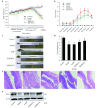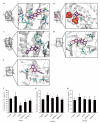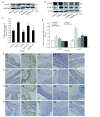Xiahuo Pingwei San attenuated intestinal inflammation in dextran sulfate sodium-induced ulcerative colitis mice through inhibiting the receptor for advanced glycation end-products signaling pathway
- PMID: 40151118
- PMCID: PMC11955771
- DOI: 10.19852/j.cnki.jtcm.2025.02.006
Xiahuo Pingwei San attenuated intestinal inflammation in dextran sulfate sodium-induced ulcerative colitis mice through inhibiting the receptor for advanced glycation end-products signaling pathway
Abstract
Objective: To evaluate the therapeutic effects of Xiahuo Pingwei San (, XHPWS) on ulcerative colitis (UC) in mice and to explore the underlying mechanisms through a network pharmacology approach.
Methods: Ultra-performance liquid chromatography coupled with quadrupole time-of-flight mass spectrometry (UPLC-Q-TOF/MS) was utilized to identify the chemical composition and authenticate the active constituents of XHPWS, ensuring rigorous quality control across batches. A dextran sulfate sodium (DSS)-induced UC model was established in C57BL/6 mice, which were treated with XHPWS in vivo. The efficacy against UC was assessed by measuring parameters such as body weight, disease activity index (DAI) scores, and colon length. Levels of inflammatory cytokines, including interleukin-6 (IL-6), interleukin-1β (IL-1β), and tumor necrosis factor-alpha (TNF-α), in colonic tissue were evaluated using enzyme-linked immunosorbent assay (ELISA). Histological analysis of colon sections was conducted using hematoxylin and eosin staining. A network pharmacology approach was employed to explore the mechanisms of XHPWS and to predict its potential targets in UC treatment. Predicted protein expressions in colonic tissue were validated using immune-ohistochemistry (IHC) and Western blotting techniques.
Results: XHPWS effectively alle viated DSS-induced UC symptoms in mice, as evidenced by restored body weight, reduced colon shortening, and decreased DAI scores. Histopathological examination revealed that XHPWS significantly reduced intestinal inflammatory infiltration, restored intestinal epithelial permeability, and increased goblet cell count. Network pharmacology analysis identified 63 active compounds in XHPWS and suggested that it might target 35 potential proteins associated with UC treatment. Functional enrichment analysis indicated that the protective mechanism of XHPWS could be related to the advanced glycation end products-receptor for advanced glycation end products (AGE-RAGE) signaling pathway. Notably, quercetin, kaempferol, wogonin, and nobiletin, the main components of XHPWS, showed strong correlations with the core targets. Additionally, experimental validation demonstrated that XHPWS significantly decreased levels of inflammatory cytokines interleukin 6 (IL-6), interleukin 1 beta (IL-1β), and tumor necrosis factor alpha (TNF-α) in UC mice, while downregulating the expression of proteins related to the AGE-RAGE pathway.
Conclusion: Our study demonstrated that XHPWS effectively alle viates colitis symptoms and inflammation in UC mice, potentially through the regulation of the AGE-RAGE pathway. These findings provide strong evidence for the therapeutic potential of XHPWS in UC treatment, thereby broadening its clinical applications.
Keywords: Xiahuo Pingwei San; colitis, ulcerative; glycation end products, advanced; inflammation; network pharmacology; receptor for advanced glycation end products; signal transduction.
Figures




References
-
- Kaplan GG. The global burden of IBD: from 2015 to 2025. Nat Rev Gastroenterol Hepatol 2015; 12: 720-7. - PubMed
-
- Yao D, Dong M, Dai C, Wu S. Inflammation and inflammatory cytokine contribute to the initiation and development of ulcerative colitis and its associated cancer. Inflamm Bowel Dis 2019; 25: 1595-602. - PubMed
-
- Rubio CA, Langner C, Schmidt PT. Partial to complete abrogation of the subepithelial macrophage barrier against the gut microbiota in patients with ulcerative colitis and Crohn's colitis. Histopathology 2018; 72: 580-97. - PubMed
-
- Lawrence T, Natoli G. Transcriptional regulation of macrophage polarization: enabling diversity with identity. Nat Rev Immunol 2011; 11: 750-61. - PubMed
MeSH terms
Substances
Grants and funding
- 2023A1515011699/Guangdong Provincial Basic and Applied Basic Research Project: Mechanistic Study on the Regulation of Inflammatory Microenvironment and Improvement of Ulcerative Colitis by Lingnan Traditional Medicine Ficus Pandurata Hance through Wilms' Tumor 1-associating Protein-Mediated RNA Methyltransferase Promoting Toll Like Receptor 4 m6A Modification
- 2022A020446/Zhongshan Medical Research Project: Mechanistic Study on the Action of Xiahuo Pingwei San in the Treatment of Ulcerative Colitis
LinkOut - more resources
Full Text Sources
Medical
